I first discovered Viburnum bodnantense in the same place I discovered many of my favorite plants – Kew Gardens.
I’ve told this story before (apologies if you’ve heard it!), but when I was in design school at The English Gardening School in London, we had to do an intensive study of a huge number of plants. Each plant we chose had to be observed and photographed through all the seasons, and Kew was the perfect place to find excellent garden plants to study and ensure that I could go back, again and again, to see what they were doing throughout the year.
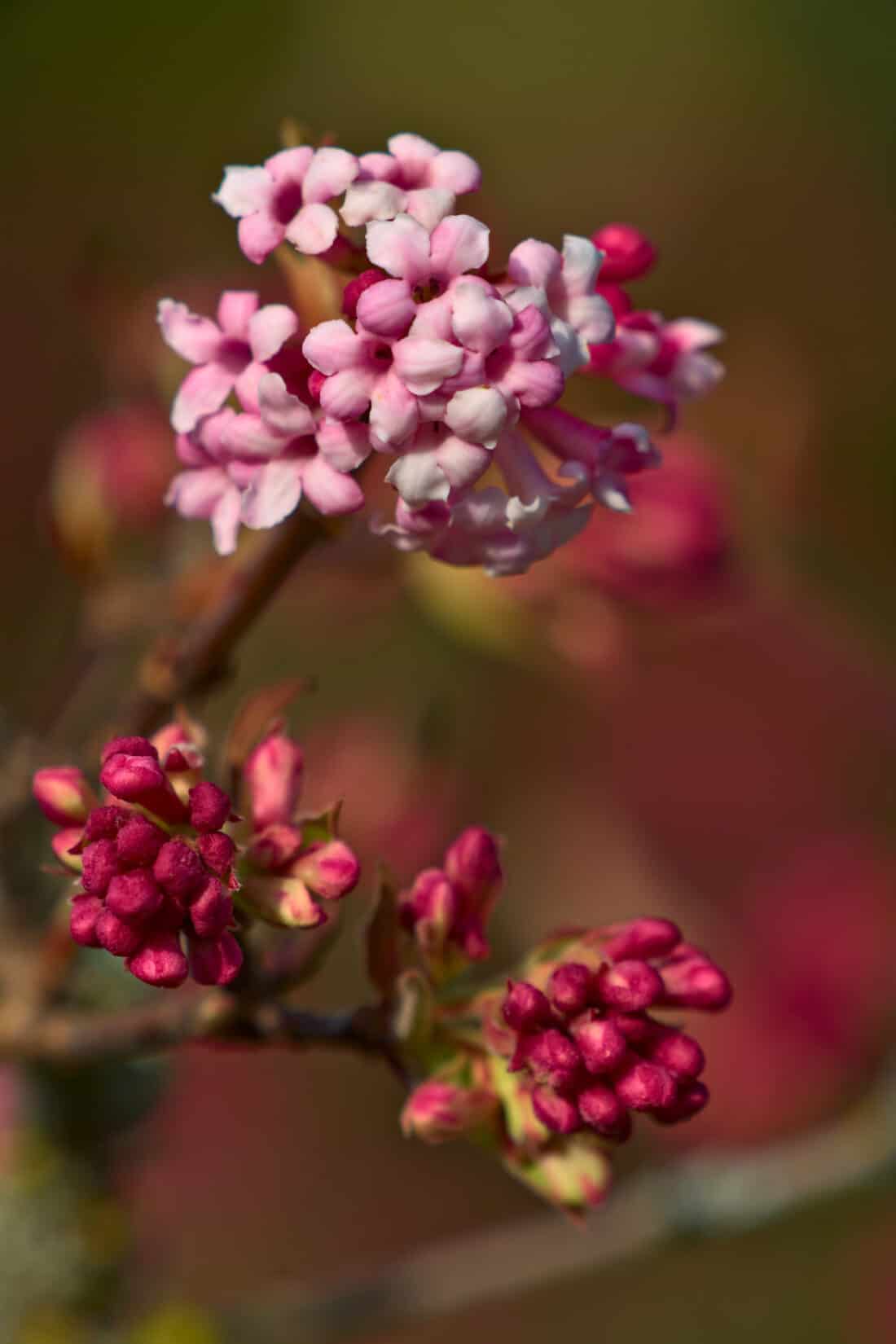
Dawn viburnum easily caught my eye on a warm day in January. Bodnant viburnum’s winter blooms combined with the sweet fragrance of this shrub were the one-two punch that stopped me in my tracks and induced love at first sight (and sniff).
Growing Viburnum x bodnantense Dawn
Viburnum x bodnantense is a hybrid viburnum – created from a cross between viburnum farreri and viburnum grandiflorum. The initial cross was developed in 1933 by Charles Lamont at the Royal Botanic Garden in Edinburgh, Scotland. But it was later, at Bodnant Garden (in north Wales), that the cross was further developed, and three famed viburnum cultivars emerged. The varieties are ‘Charles Lamont’, Dawn’ and ‘Deben’.
My personal favorite is ‘Dawn’. Charles Lamont is meant to bloom earlier and has larger leaves, but since I choose this shrub more for its winter bloom, I find that sometimes earlier is not better in New England. Earlier means it might just be too early, and I miss it entirely because the snow just pervades.
Deben is also lovely – but it has white flowers that have pink tinges, whereas Dawn’s flowers are solidly rosy and can range from soft pink flowers to dark pink flowers. But most importantly – they are fragrant pink flowers (Deben’s scent is not as strong).
‘Dawn’ has also earned the prestigious Royal Horticultural Society’s Award of Garden Merit (AGM) for its garden-worthy qualities.
A Perfect Winter Blooming Shrub
Pink dawn emerges in the dead of winter – precisely when I am craving the garden and flowers more than ever. The pink blooms of Viburnum x bodnantense are great in the garden – but also, they are among the earliest branches that I can cut and bring inside for forcing. The flowers hang onto the bare stems and make for an easy winter arrangement.
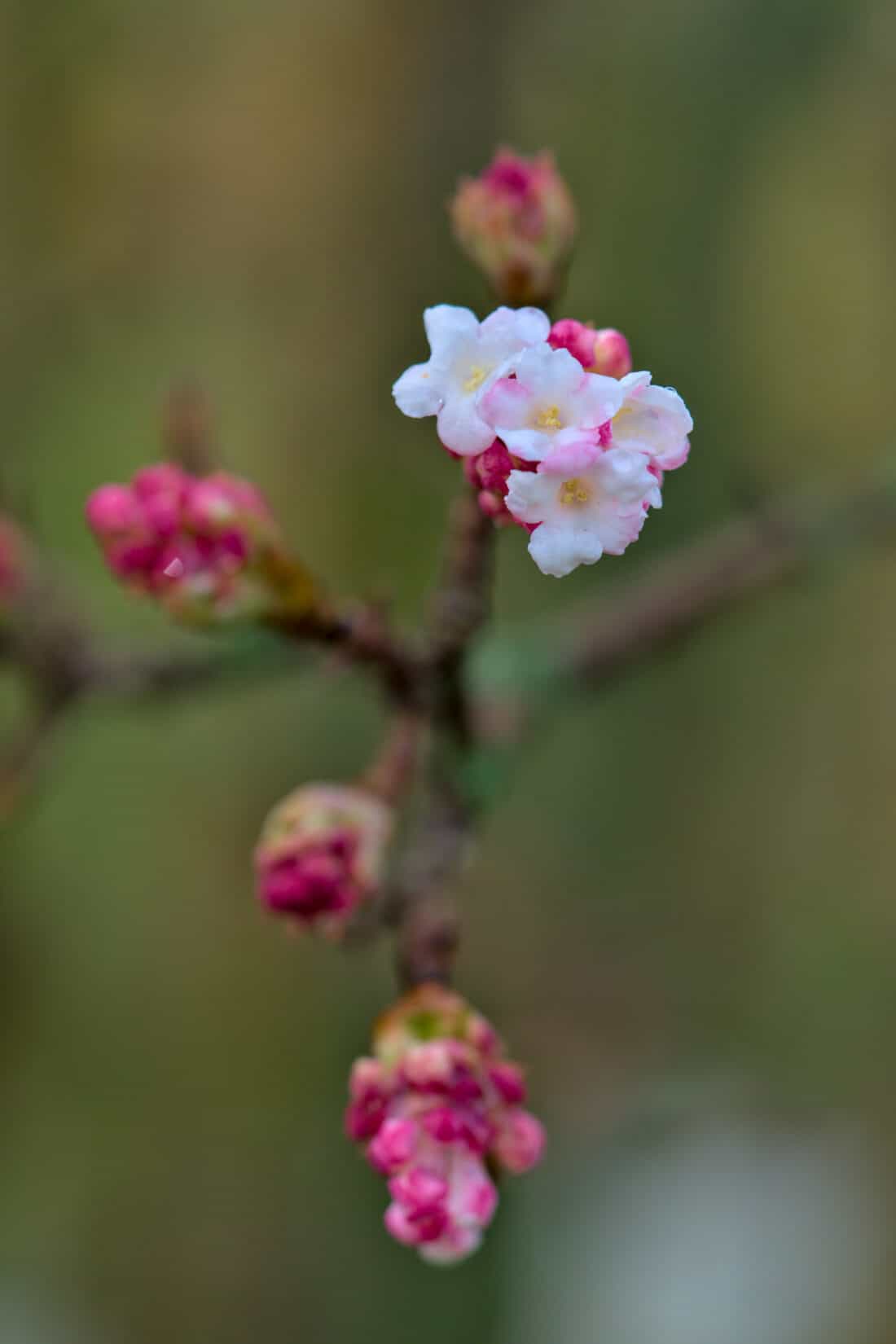
This stalwart of the winter garden has the most amazing scent – it regularly catches me off guard in the garden. It just isn’t what you expect to sniff when there is nothing but frozen brownness everywhere.
The scent is feminine and musky, with a hint of clove and the sweetness of clover and berries. You will love it in your home. These fragrant flowers persist throughout the dead of winter – often from late autumn to early spring.
After blooming, Viburnum bodnantense develops red to black berries that are a food source for birds, contributing to garden biodiversity. The fruit of Viburnum bodnantense is edible to humans as well, and I have heard of gardeners experimenting with its use in jams and jellies. In my own garden, I have actually never noticed the berries. I suspect the birds take them, and they aren’t a particularly special feature anyway.
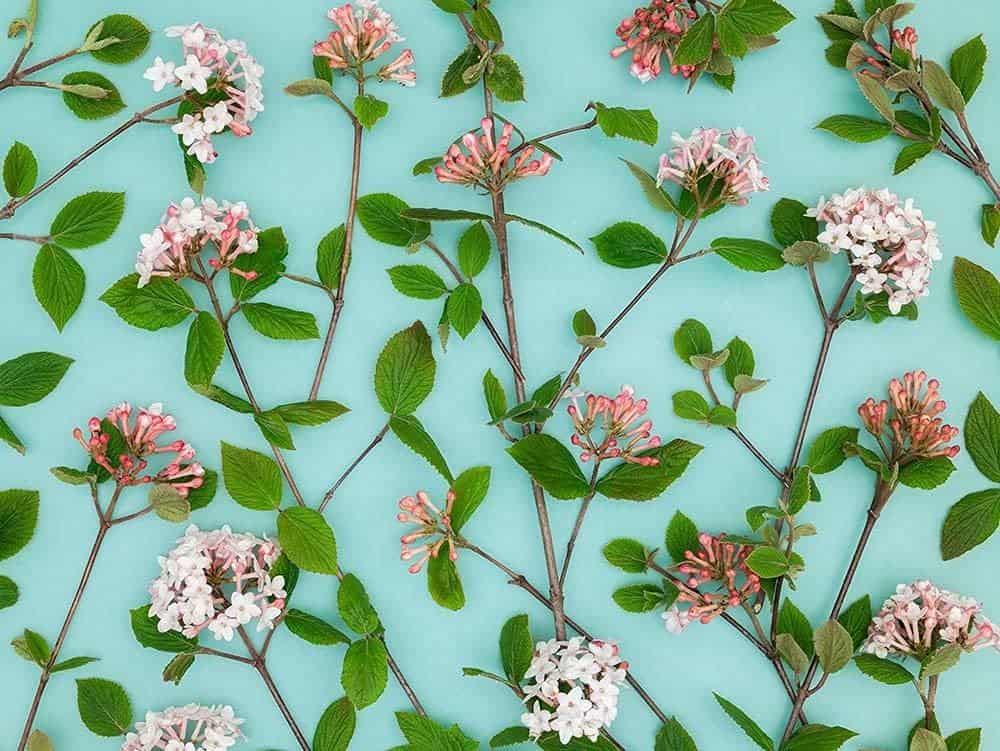
Five ideas for designing with Viburnum bodnantense Dawn
Are you intrigued? Perhaps you want to think about planting it in your landscape?
Here are some ways to design it in your garden.
1) Create a Vibrunum pink dawn informal hedge.
Viburnum x bodnantense is generally a vase-shaped shrub, narrow at the bottom and opening up to the top. If you plant them roughly 3 feet apart, you create a reasonably full, deep green hedge in the summer.
This is a deciduous shrub, so it will be a beautiful blossom-filled twig hedge (flower clusters form on naked stems) in the late winter and early spring. Consider putting the hedge in front of something evergreen so that the white and pink flowers have added sparkle.
Their mature size can be substantial (8-10 feet) if planted in full sun. In my garden – I have it planted in partial shade, and it has stayed a bit smaller – topping out after many years at only about 6-7 feet. It is hardy to USDA zone 5 (I am right on the edge), and I have found it needs a somewhat protected location to really thrive (or even survive – I lost a couple in early planting experiments).
2) Use Viburnum Dawn to soften strong horizontal lines.
This shrub has a strong vertical line presence, so using it to contrast something else that has a strong horizontal presence (like the siding of a house or a barn or perhaps even a strong horizon line) can provide balance and design interest.
Try planting it at the back of a border – in front of a fence. Its dark green deciduous foliage will provide a nice backdrop to other plantings during the spring and summer. In the fall, the leaves generally provide good color, fading into reds and oranges.
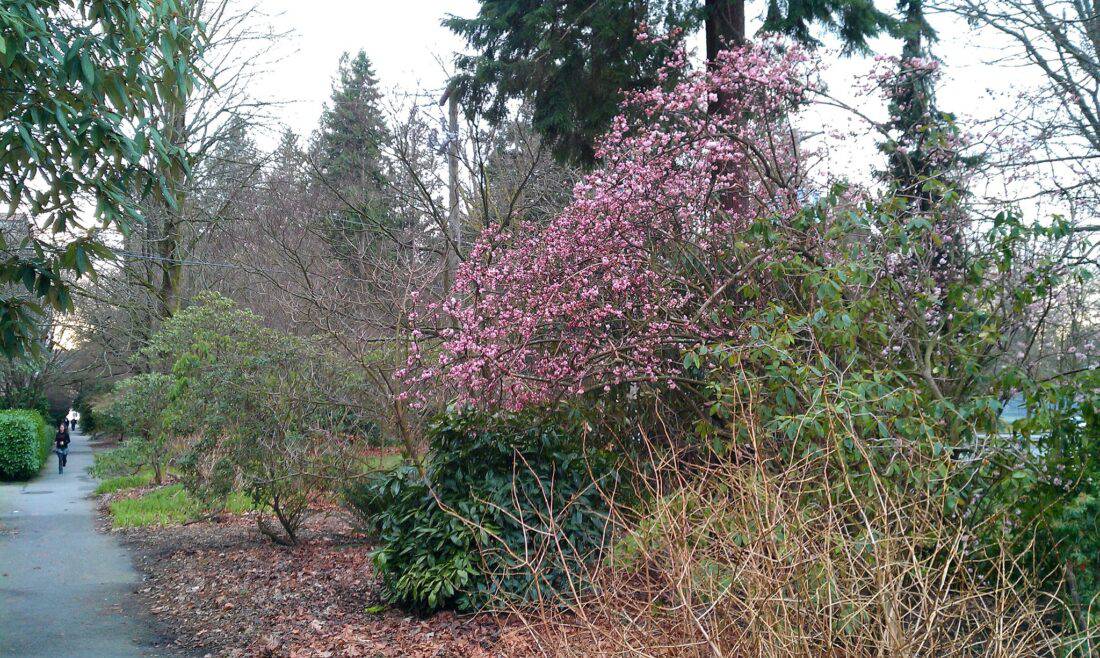
3) Create an Asian-inspired garden (particularly in areas where snow cover is less dominant).
This viburnum is not native to North America – it is a hybrid, bred in England, from plants native to China. Consider honoring the natural plant partners with other Asian garden-style plants.
Consider underplanting it with mosses and other vibrant evergreen ground covers. These types of plants will serve the same purpose as an evergreen backdrop but will also provide a sea of green so that as the soft pink and white blooms fall, they can be equally appreciated after they have passed.
In China, viburnum is traditionally associated with the Chinese New Years, symbolizing good luck and fortune.
4) Plant Viburnum in a cutting garden.
If you are in warm winter areas (like England or down the mid-Atlantic coast of the United States) you will more likely be growing this shrub in its most ideal conditions.
These are a relatively low maintenance shrub, but you will occasionally need to prune away an errant stem. (I’ve done very little pruning – mine has only needed a cut just a few times in the 10+ years that it has been in my garden).
You will get the best flowering from a shrub that is well-sited and growing to its full potential. This will also mean there are plenty of branches for cutting.
If you are planning a cutting garden – you might consider this one of a selection of large shrubs that you can include. The stems are among the earliest and most beautiful harbingers of spring, and when brought in and used in floral displays, they can be the heart of beautiful sculptural arrangements.
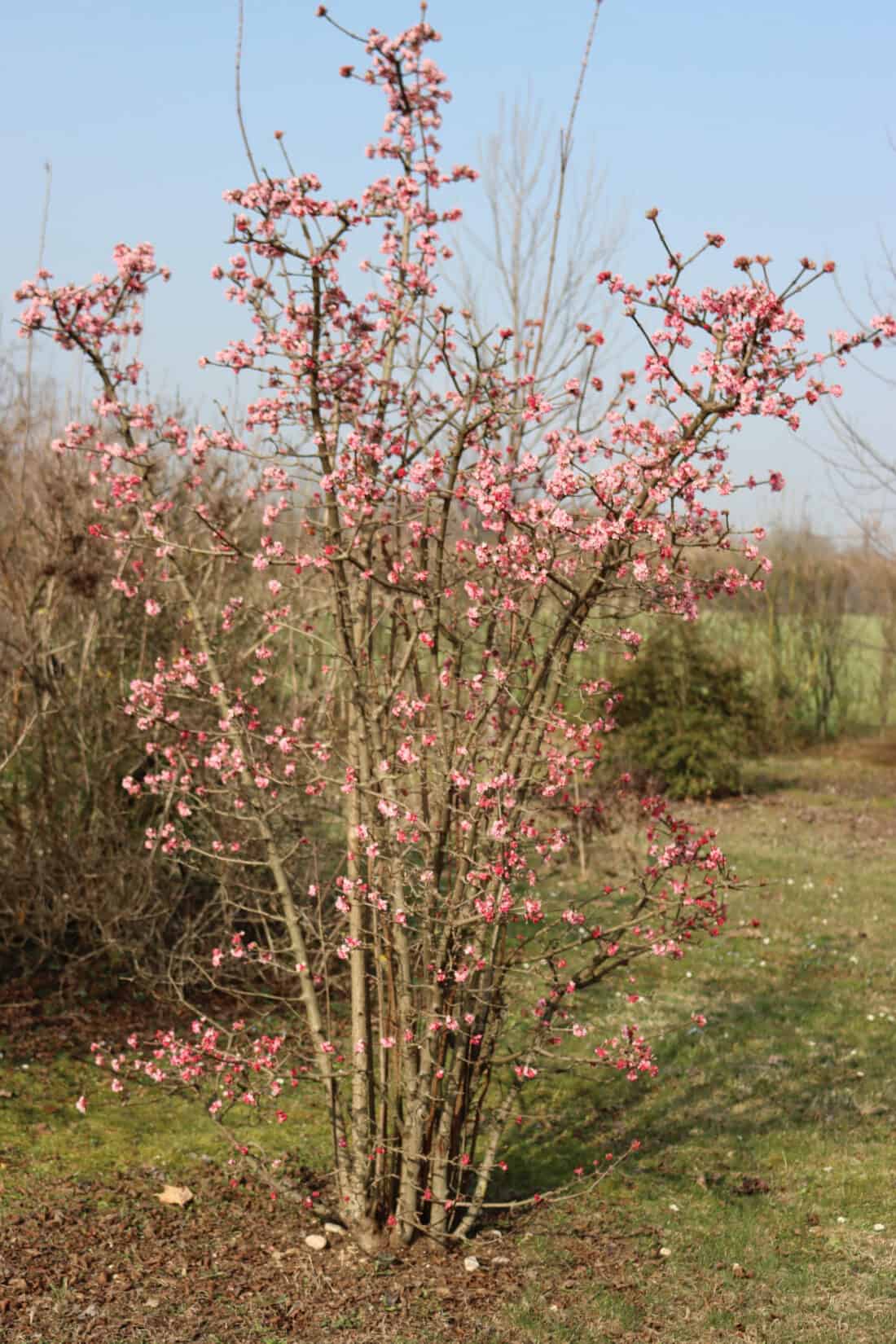
5) Other Dawn Viburnum Plant Pairings You might consider:
This viburnum thrives in a range of soil types (though it generally prefers well-drained soils) and is adaptable to both sun and partial shade – I have chosen plants that work in similar conditions.
Dryopteris felix-mas – Planting ferns nearby can add a lush, textural contrast to the garden.
Polygonatum biflorum – Smooth Solomon’s seal is a native (to many areas of the USA) woodland plant with arching stems. Its shapes will interestingly reflect the shape of viburnum bodnantense.
Hellebores (Helleborus) – These early blooming perennials offer a lovely contrast to ‘Dawn’s’ pink blossoms and provide additional winter interest.
Winter-flowering Witch Hazel (Hamamelis) – Pairing ‘Dawn’ with the fragrant flowers of witch hazel creates a delightful winter display.
Planting spring bulbs like snowdrops (Galanthus) and crocuses (Crocus) nearby can enhance the garden’s early-season appeal.
Heathers (Calluna and Erica) – These low-growing evergreens provide year-round texture and color, making them a great choice for companion planting.
Spring-Blooming Shrubs – Complement ‘Dawn’ with other spring-flowering shrubs like forsythia (Forsythia), which adds vibrant yellow blooms.
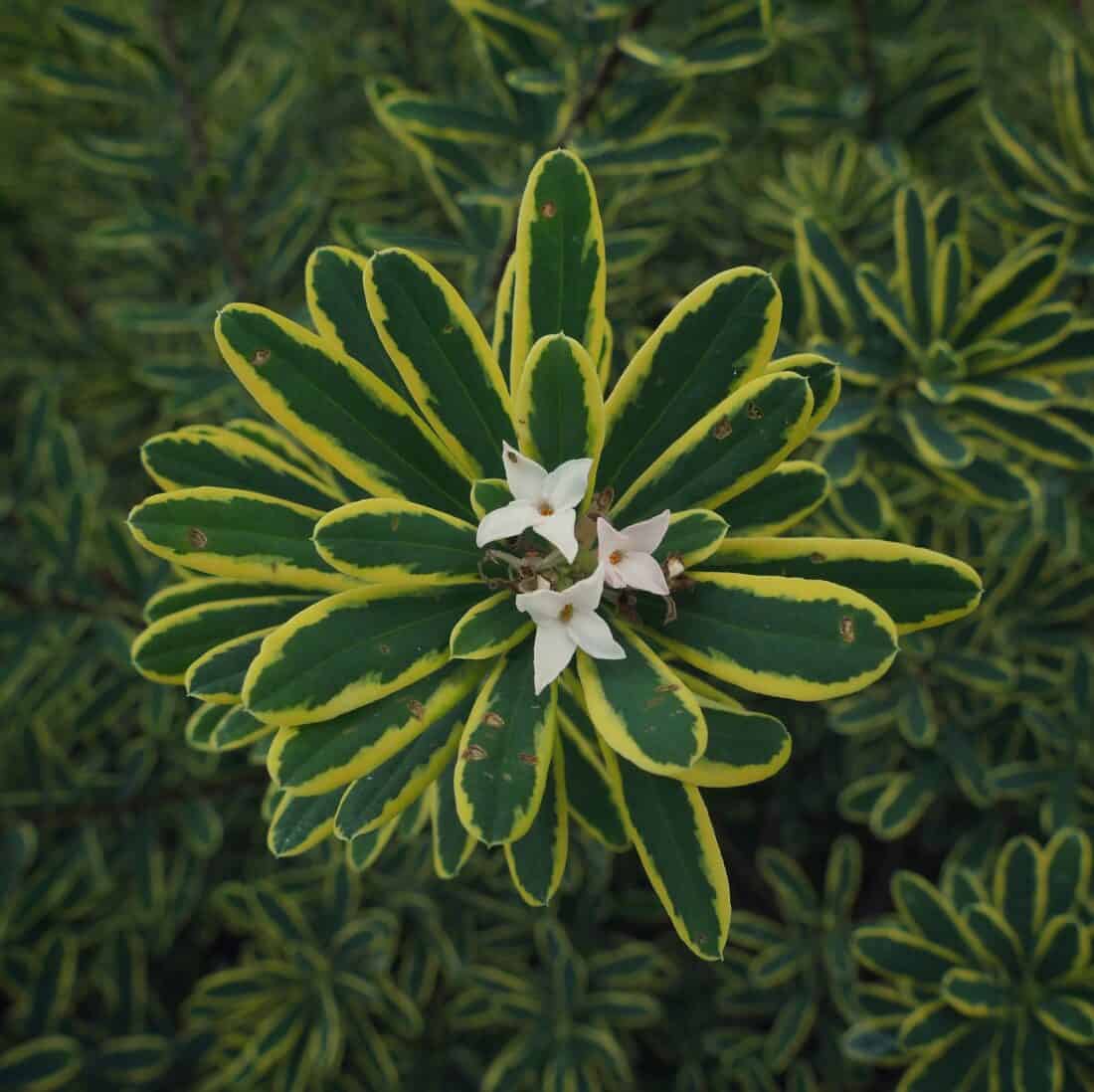
Fragrant Evergreens – Fragrant evergreen shrubs like Daphne and Sarcococca can provide year-round scent and visual appeal.
Heuchera (Coral Bells) – These perennial plants offer a diverse range of foliage colors that can contrast or complement ‘Dawn’s’ blooms.
Companion Viburnums – Other Viburnum species, like Viburnum tinus or Viburnum carlesii, can create a harmonious grouping in the garden.
Ground Covers – Ground covers like Lamium, Vinca minor, or Epimedium x perralchicum can help fill in spaces and suppress weeds while offering attractive foliage.
Hostas – The heart-shaped foliage of hostas complements the shrub’s blooms and adds a layer of greenery.
What a useful little entry-Will be sure to be back!
(I’m home feeling too moody/PMS for work, so please excuse me if I rant)
Instead of 5 ways to use this plant, I would much rather read a battle of champion plants. Especially for a plant this size, it’s more common, IMHO, to have a spot and think, well now, should I go Dawn Viburnum or a Winter Hazel? I can get some information on each online, but it’s harder to find comparisons. Which one will give more privacy in a lot line year round? Which one is more shade tolerant? Even as a web article, post an empty spot, and two or three choices to fill it, and let people comment.
private – I love the idea of battle of the plants….no worries about being PMS-y— I happen to be in a state of little inspiration, so a comment such as this actually is quite helpful towards generating new post ideas. thx. -R